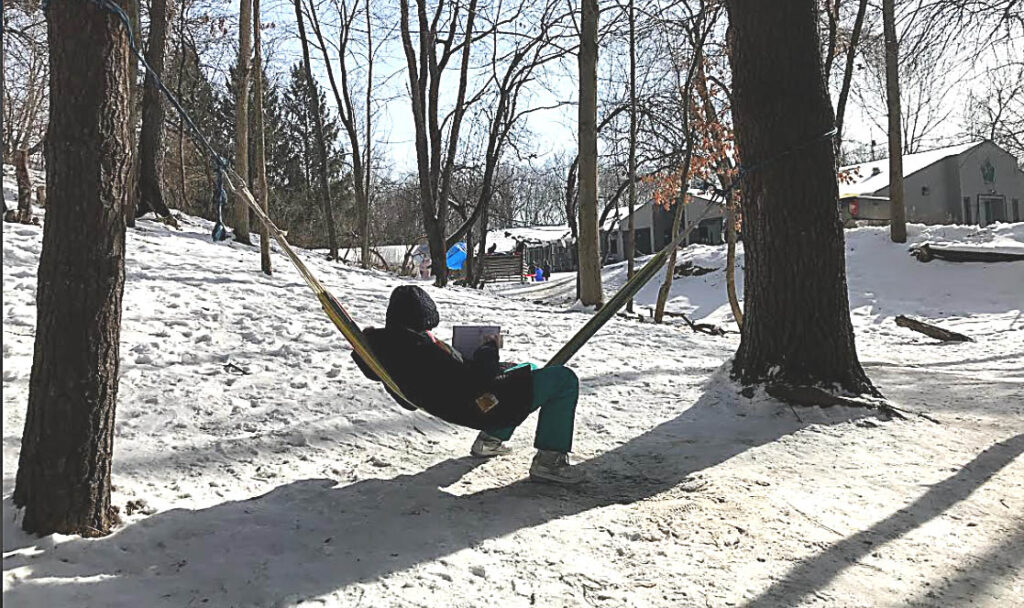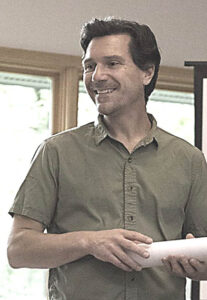
By James Hanlon
Leader Staff Writer
As schools across the country struggled to find a safe way to return school this year, a small private school in Oxford had a simple solution: have class outside as much as possible, even through the bitter Michigan winter.
The cold snap in early February “was a little tough,” said Upland Hills School’s director, Rob Himburg, “but I think we are very well acclimatized at this point and the kids are really thriving.”
Founded in 1971, the independent K-8 school surrounded by Upland Hills Farm located at 2575 Indian Lake Rd. has a 50-year history of outdoor-based learning. Even before the pandemic, the school’s 90 students spent roughly half their day outside.
“We’ve done a lot of our school day outdoors in all years previous to this one, we just took it to a way different level this year,” Himburg said. “So, it’s not totally foreign to us or an unknown, but the degree to which we are doing it, certainly feels much different.”
This year, the school pitched military-grade canvass tents for each class around campus to use during inclement weather. The tents are well-ventilated and can be heated up to 60 degrees, so it’s okay for students to have their hands out for writing lessons.

Student also have their own personal tent as a private study space. “It’s a way that we can keep them safe and give them that sense of comfort and security that they need at the moment and still focus on academic learning,” explained teacher Robert Crowe.
Besides tents, they only occasionally go inside the buildings, masked up in small groups of five or six students, so they can stay properly distanced.
The outdoor situation did not worry Haley Burns, parent of two students aged five and seven. “At Upland Hills they consider the natural environment their core teacher anyway, so that means our kids are outside a lot, even on a normal year,” she said.
When their kids started at the school, the Burns family lived in Pleasant Ridge and their commute was almost an hour. “We weren’t sure if this was the school for us, or what, but we absolutely just fell in love with the philosophy and our kids were so happy, so we moved to Oxford.”
Before school started in August, the school laid out a plan that carefully envisioned the outdoor classroom. “I think if we hadn’t had such a plan, there might have been more anxiety around the drop in temperatures in February, but they were just so ahead of the game,” Burns said.
The plan has been effective. Except for one cohort that quarantined around Halloween because of a possible exposure, the school hasn’t had to take any days off because of the coronavirus.
The students have responded well to the situation. “You know, I think it’s more us adults that have had more of a struggle,” laughed Himburg. Even so, he’s become more used to it. “I don’t think I’ve been this comfortable outdoors since I was a little kid. So there’s an aspect to outdoor, nature-based learning that we’ve all returned to in that way.”
His two children who attend the school say, ‘we don’t want to go back. We want to keep school like this, even when we don’t have to.’
Burns hopes for the same. “This has taught everybody that we really can be outside more than we thought we could.” Her children come home with rich stories to tell. Immersed in nature, watching their teachers build fires and cut wood, has brought them closer because they have been through this experience together.
“It’s tiring,” Himburg acknowledged. “It’s harder to go to school this way. But, I think in terms of quality of the experience they’re getting, they’re still getting a full and good academic experience, but the intangible experience they’re getting this year has been huge.
“Sometimes just dealing with the elements, sometimes you’re cold, sometimes you’re a little wet. You can be distracted by that, which can be more of a challenge for the learning aspect. But we’ve been out-front about seeing it as an opportunity to build your muscles, so to speak, around ability to concentrate and be resilient.”
Besides the natural elements and limited resources, the real challenge has been learning and maintaining all the new Covid safety protocols and facing the unknown. “When we embarked on this in mid-August, no one had any idea what would actually happen when people went back to school,” Himburg said. “Would there be lots of transmission, would it contribute to community spread? We didn’t have any of those answers at that point. So, that was challenging, not knowing what was going to happen and feeling that responsibility. I feel like any industry that’s open right now has this incredible responsibility to do it the right way.”
By the end of last school year, it was clear to the school staff they needed “to model the kind of solution finding and creativity and agency that we wanted our students to experience . . . The more creative and open-minded we could be, the more we were able to find answers to these really hard questions about how to be in school.”
As a school whose primary teacher is the natural world, there was plenty to learn this year. “Concepts in science, especially in natural science like adaptation, have never felt more present or necessary. You see that there is no separation between us and the natural world except for the arbitrary constructs we create that separate it . . . The idea that we’re interconnected as a community, just like nature is, has given us a lot of strength and resilience to deal with the hard parts and uncertainty that’s existed this year.”
Burns realized that this year could have been an anxious experience for her kids. “They were spared a lot of that and instead were just immersed in this magical outdoor environment. I feel so lucky about that.”

Leave a Reply